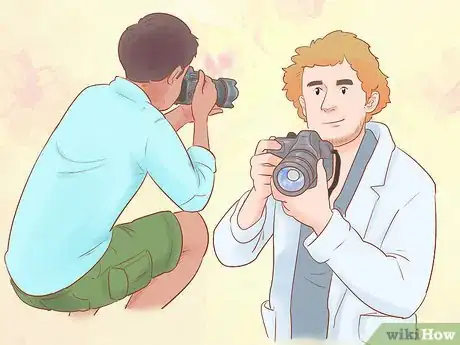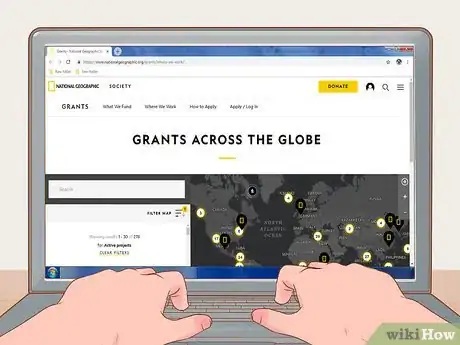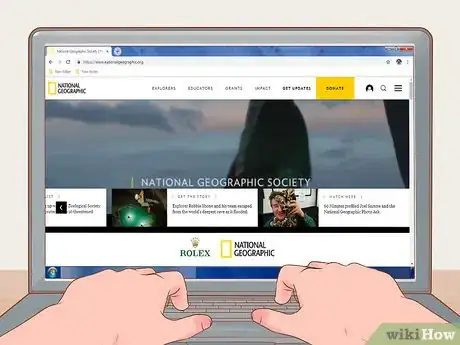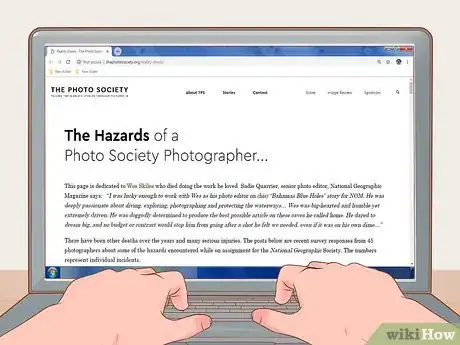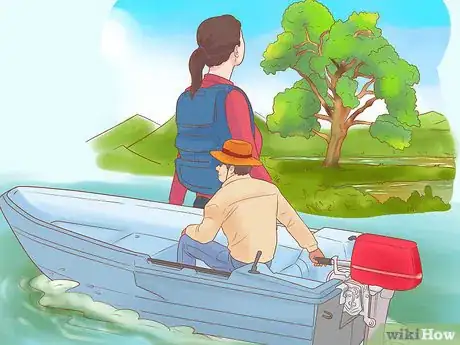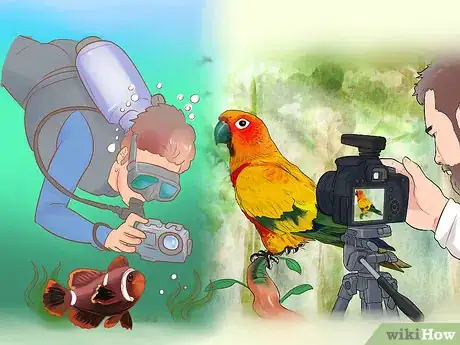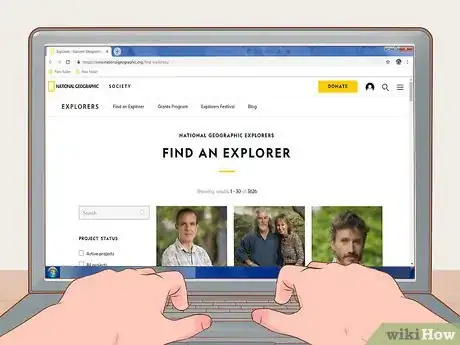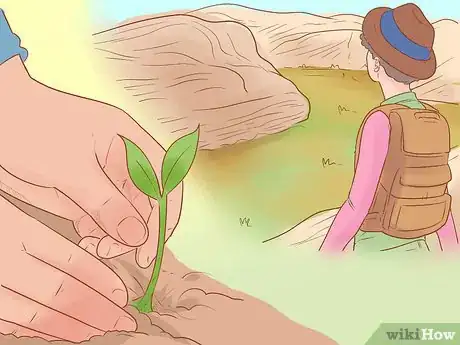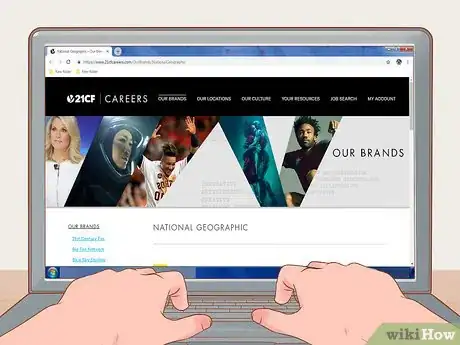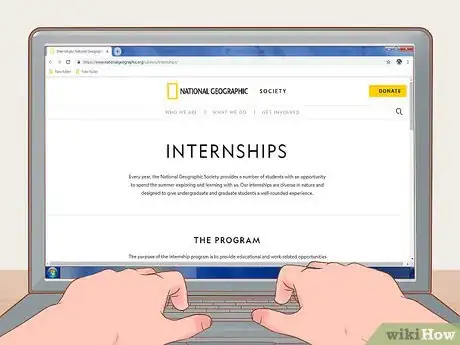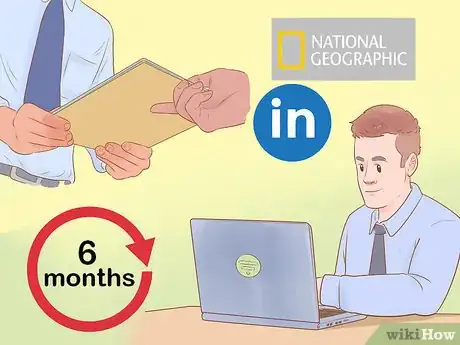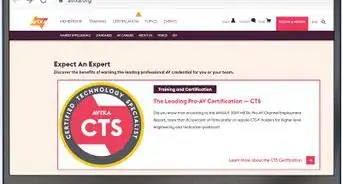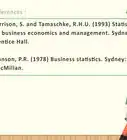This article was co-authored by wikiHow Staff. Our trained team of editors and researchers validate articles for accuracy and comprehensiveness. wikiHow's Content Management Team carefully monitors the work from our editorial staff to ensure that each article is backed by trusted research and meets our high quality standards.
This article has been viewed 30,629 times.
Learn more...
National Geographic is a global community of journalists, photographers, filmmakers, and scientists that entertain and educate the community through magazines and television channels. Are you interested in becoming a part of this community? With a bit of research and lots of hard work and dedication, you can begin the fascinating journey of working for National Geographic by channeling your passion to create and explore.
Steps
Choosing Your Focus
-
1Look into journalism jobs at National Geographic if you love to write. Take a look at the journalism jobs offered and the requirements for each. Typically, writers have some education in journalism, sciences, and English. But it's important to remember that National Geographic values passion and exploration in addition to academic background.
- Consider all of your interests, such as history, and think of how they can fit into the journalism offerings. Are there places you can visit that have a history you're familiar with or interested in? Do you want to create a unique story documenting your time and perspective?
- Knowing multiple languages is beneficial. Consider applying for a course to learn one that interests you and aligns with places you would like to travel to and explore.
-
2Search for photojournalism jobs if you have a knack for imagery. When it comes to photojournalism, most National Geographic photographers come from a discipline outside of photography. Look at potential jobs and ask yourself how your current experience ties into them. Do you have a sociology background? Consider a photojournalism course in a country where you can use photos to capture different societies.
- Consider enrolling in a photo course either in school or through a private institution.
- Take a look at the National Geographic photography website for photo and style ideas, as well as tips from their pros.
Advertisement -
3Examine the current explorer projects and see what interests you. National Geographic has people around the world at all times conducting a variety of exploring projects, from the psychology and ecology of fishing practices to the movement of peat swamp crocodiles in Borneo. Take note of the projects and geographic regions that interest you most and start brainstorming your own.
- Research the travel and tourism options for geographic regions that you're interested in.
-
4Consider a behind-the-scenes job if you have a particular area of expertise. If you have a unique focus that you believe would work well with National Geographic, take a look at their job listings under the National Geographic Society. There are always plenty of opportunities, such as accounting, research, and analysis.
- If you have a current job or degree, look for listings that align with your experience. For example, if you have a geology degree, look for research positions seeking people with this degree through employers like National Geographic GeoBee.
- Check job listings to get an idea of what kinds of positions are offered. Make a list of the ones that interest you and use this to get a feel for your options.
-
5Research the dangers of each job and be realistic. Working for National Geographic can be a rewarding and eye-opening career, but it can also be dangerous. If you're planning to be a photographer, writer, or explorer, chances are you're going to be in some dangerous situations. You might be exposed to bites and dangerous animals or have to conduct work in regions of the world that are less safe than many countries. The most common injuries are: severe dehydration; frostbite ;arrests; paraglider crashes. Other risks include being detained, threats and abductions.
- Take a look here for some examples of injuries incurred on the job: http://thephotosociety.org/reality-check/.
- Consider less dangerous jobs within the National Geographic network, such as business or management positions.
Obtaining Necessary Experience
-
1Create your own nature expeditions. Whether you want to be a writer, photographer, or explorer, expeditions are a great way to get both inspiration and experience. Natural Geographic is all about telling a story via many kinds of media—use your skills to create a story on your expedition and figure out the things that interest you most. Explore as many places as you can and dabble in everything from writing to photography.
- If you're just getting started or under the age of 18, plan some day trips to local wildlife and conservation areas.
- If you have a bit more experience and are over the age of 18, plan an international trip to somewhere you'd like to explore, such as Africa, Thailand, or any one of the many national parks in the United States.
- Write a story about your expedition and post in on a personal blog.
- Take photographs of your journey and add them to your portfolio.
-
2Gain at least 5 years of professional experience for photojournalism jobs. If you want a photography career at National Geographic, get some experience in professional photojournalism in a specialty of your interest. Some specializations include underwater photography, aerial photography, and nature. Start creating your own photos and post them to an Instagram page to get your work out there!
- Invest in a college degree in science, journalism, sociology, anthropology, fine arts, or a related discipline for a better chance.
- Don't be afraid to get different kinds of photography experience—the more variety you have in your experience, the better your chances.
- Go on a National Geographic Photo Expedition, attend a Photo Workshop, or take an Online Photo course.
-
3Build relevant writing experience if you're interested in journalism. National Geographic writers are freelancers who are assigned story ideas—commonly with a science and nature focus—by editors who have worked with them before. Since they don’t accept unsolicited submissions, your best bet is to gain as much experience as you can at high-profile journalism publications with a focus on science. The only exception is National Geographic Traveler—send your freelance pitches to them!
- Search for publications in your area looking for freelance submissions. Look for publications that focus on your areas of interest or expertise.
- Send story ideas and links to your work to editorial@natgeotraveller.co.uk.
- Apply to as many different publications as you can, even if it's just freelance work.
-
4Focus on traveling experience if you want to be an explorer. Although there are no set requirements for explorers, having a knack for traveling the world and utilizing your interests and education along the way is a definite must. For example, if you're a marine research scientist, travel somewhere with dwindling marine ecosystems and connect with local businesses and researchers looking to help it grow.[1]
- Look at current explorer projects for ideas: https://www.nationalgeographic.org/find-explorers/.
-
5Develop your skills to focus on storytelling, research, and conservation. Take your education and interests and channel them into desirable National Geographic skills. Are you a history major? Take a writing course if you're interested in journalism and then travel to historical landmarks and document your travels. If you're taking a research science course, take a photography course and capture your work.
- Get in the habit of constantly asking yourself how your unique work and skills can tell an innovative story about the world around you.
- Complete as many projects as you can within your focus to give yourself marketable skills.
- Regularly brainstorm new projects.
-
6Enroll in a college or university program with a relevant focus. National Geographic values unique experience more than anything. Don't cater your education to a job in National Geographic—do something you enjoy! As you progress through your degree, ask yourself how your learning can be applied to projects that would be beneficial for National Geographic. For example, if you're studying sociology, consider regions of the world that you would like to explore and conduct sociological studies.
- Select courses that can translate into experience for your desired job, such as photography courses or writing courses.
Finding National Geographic Jobs
-
1Check jobs from National Geographic Partners for various media roles. Whether you're interested in photography or journalism, National Geographic Partners offers jobs in their television and production arm. Search by brand, function, job type, location, or language depending on what you're looking for.[2]
- Search by "Job Function" and select "Editorial" for journalism.
- If you're interested in photography, search by "Category" and choose "Film Production," "Digital," "TV Production," or another related category.
- Select listings here: https://www.21cfcareers.com/OurBrands/NationalGeographic.
-
2Look for jobs in National Geographic Society for a variety of job choices. National Geographic Society has a more varied array of job listings, from security engineer to grant director. Search by location, job type (fixed term, regular), or full-time/part-time.[3]
- Keep an eye out for jobs that match your experience, education, and skills.
- Search job listings here: https://ngs.wd1.myworkdayjobs.com/ngs_external_career_site.
-
3Apply for a summer internship if you're in college or university. For undergraduate and graduate students, National Geographic offers summer internships to gain experience and job-related skills. It's the best way to get your foot in the door and develop experience regardless of what your focus is. Look for open positions on their website in January and apply via the online application. Remember to submit a resume and cover letter.
- Check out open positions here: https://www.nationalgeographic.org/careers/internships/.
- Contact careers@ngs.org for questions.
- Make sure you are authorized to work in the United States.
-
4Submit a grant application if you have a unique exploration project. Explorers in the fields of research, education, conservation, and technology are eligible for a grant. National Geographic prefers projects that are not just strictly research work and integrate experiences outside of the laboratory. In addition, it must fit into one of three categories: Wildlife, the Human Journey, or the Changing Planet.
- Check here for the application and guidelines: https://www.nationalgeographic.org/grants/grant-opportunities/.
- Make sure your project doesn't take place in restricted countries like mainland China, Cuba, North Korea, Iran, Sudan, Syria, or the Crimea region under Russian control.
- If you work in a research lab, brainstorm project ideas that use your skills on a broader scale. For example, a project that tracks endangered species in a unique region of the world.
- If you work in education, think of a project that seeks to educate children in other parts of the world to empower them.
Applying for a Job
-
1Create your resume and cover letter. Include all of your relevant employment and educational history in your resume. List all of your special skills and qualifications—National Geographic values these highly. When it comes to personal information such as values and the things that drive and motivate you, save them for your cover letter.
- Always include your best references with your resume, as well as volunteer history and any internships you completed in college or university.
- In your cover letter, be sure to explain how the unique skills listed on your resume connect to your career, how you are working to better understand and change the world, and why this will help you in National Geographic.
- Let your passions and dedication shine through! National Geographic is very selective and values people with lots of unique and varied experience.
-
2Create an account on the National Geographic job listing site. Both National Geographic Partners and National Geographic Society operate via the Workday database. The database allows members to apply for National Geographic jobs via their server. To use it, you need to create an account by providing your email and a password. From here, you can upload your resume, cover letter, and experience.
- Visit nationalgeographic.com/jobs and click "Search Jobs." From here, click "My Account" or "Sign-In," and then "Create an Account."
- Make sure your resume is in DOC, DOCX, HTML, PDF, or TXT file types.
-
3Submit your application via the National Geographic website or LinkedIn. Once you have your resume and cover letter, visit the job listing that interests you and submit an application. Each application is a bit different, but be sure to have all of your relevant information ready (references, personal information).
- Due to the competition for National Geographic jobs, expect to wait at least 6 months to hear back for acceptance. However, you won't always hear back if they aren't interested.

